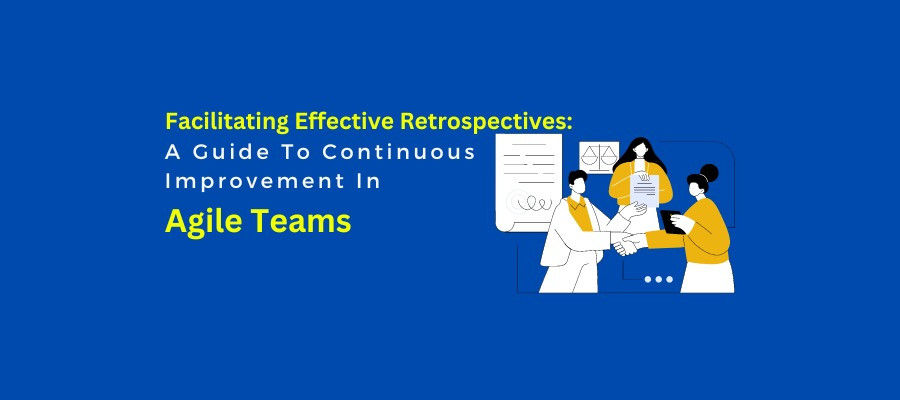Facilitating Effective Retrospectives: A Guide To Continuous Improvement In Agile Teams

Whether you are the Agile Leader or The Product Owner, conducting Team Retrospectives is your responsibility to connect with the Agile Teams. Unlike generic meetings, Retrospectives happen in a pre-planned manner with a structured opportunity for everyone to participate and contribute—Developers, Scrum Masters, Product Owners, QA Analysts, and others join Retrospectives to reflect on their work and identify areas for improvement.
But, as a responsible organizer, how can you ensure your Retrospectives are genuinely effective? Let's explore the strategies and best practices for facilitating Retrospectives that can drive meaningful changes across your organization!
Why Are Retrospectives Essential Elements Of Agile Scrum?
Retrospectives are not just routine meetings; they are vital for the growth and development of Agile teams. Here’s why:
- Retrospectives create a regular cadence for reflecting on successes and failures, encouraging teams to evolve and improve continuously.
- These meetings foster open communication and collaboration, helping to build a stronger, more cohesive team.
- Retrospectives provide a platform for addressing issues and brainstorming solutions, preventing recurring problems.
- They ensure that the team stays aligned with the project's goals and objectives, making necessary adjustments to keep on track.
Tips For Preparing Effective Retrospectives:
Effective Retrospectives start with thorough preparation. Here’s how to set the stage for a productive session:
Set a Clear Agenda:
A clear agenda helps keep the meeting focused and ensures that all necessary topics are covered. A typical agenda might include:
- Introduction: Brief overview of the meeting’s purpose.
- Review: Connect with team members to track what went well and what didn’t.
- Identify: Pinpoint areas for improvement.
- Action Plan: Develop actionable steps to address identified issues.
Choose the Right Tools:
Using the right tools can enhance the Retrospective experience. Consider using:
- Collaboration Tools: Tools like Miro or MURAL for visual brainstorming.
- Task Management Software: JIRA or Trello to track action items.
- Feedback Platforms: Tools like Retrium or Parabol to facilitate structured feedback.
Create a Safe Environment
Ensure that team members feel safe to speak openly. This involves:
- Establishing Ground Rules: Set guidelines for respectful and constructive communication.
- Encouraging Participation: Make sure everyone has an opportunity to contribute.
- Fostering Trust: Build a culture where feedback is seen as a tool for improvement, not criticism.
Conducting the Retrospective
With the preparation done, it’s time to conduct the Retrospective. The following best practices are for conducting seamless Retrospective sessions among Agile Reams. Here are the steps to follow:
Start with a Check-In:
Begin the meeting with a quick check-in to gauge the team’s mood and readiness. This could be a simple “How are you feeling today?” or a more structured activity like a “mood chart.”
Review the Previous Sprint:
As said earlier, discuss what objectives were completed and what didn’t during the last Sprint. Use visual aids like charts or boards to help illustrate points. Encourage specific examples to provide clarity.
Identify Improvement Areas:
Continuous learning and growth are the core of the Retrospective. Use techniques like:
- SWOT Analysis: Identify Strengths, Weaknesses, Opportunities, and Threats.
- 5 Whys: Drill down into the root causes of issues by asking “why” multiple times.
- Start-Stop-Continue: Discuss what the team should start doing, stop doing, and continue doing.
Develop an Action Plan
Translate insights into actionable steps. Assign clear responsibilities with pre-set deadlines for every Scrum and Development team member. Use SMART criteria (Specific, Measurable, Achievable, Relevant, Time-bound) to define actions clearly.
End on a Positive Note
Conclude the meeting with a positive activity, such as acknowledging individual contributions or sharing a motivational quote. It helps end the session on an uplifting note and reinforces team cohesion.
Final Stage: Following Up On Retrospectives
The effectiveness of a Retrospective is determined by the actions taken afterward. Here’s how to ensure continuous improvement:
- Track Action Items: Use a task management system to track action items from the Retrospective. Review progress regularly during daily stand-ups or team meetings.
- Hold Accountability: Ensure that team members are accountable for their assigned tasks. Regular check-ins make it easy to track down the latest updates.
- Measure Impact: Assess the impact of the changes made. Are there improvements in team performance or project outcomes? Use metrics and feedback to evaluate the effectiveness of the actions taken.
- Iterate and Improve: Regularly seek feedback on the Retrospective process to keep them effective and engaging and make adjustments as needed.
Can You Now Conduct Effective Retrospectives?
Facilitating effective Retrospectives is a critical skill for any Agile Leader. By setting a clear agenda, choosing the right tools, creating a safe environment, and following through on action items, teams can ensure that Retrospectives lead to meaningful improvements. Remember, the goal is continuous improvement; each Retrospective is a step toward becoming a more efficient, cohesive, and successful team. So, embrace the process, learn from each session, and watch your team grow and excel.
Reference:
https://www.scrum.org/resources/blog/retrospective-facilitation-simple-hack-go-good-great
https://www.scrum.org/resources/facilitation-techniques-sprint-retrospective



